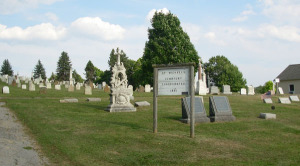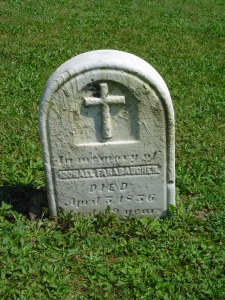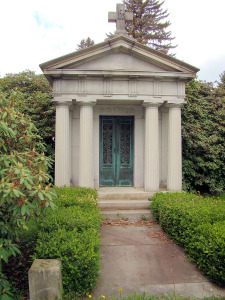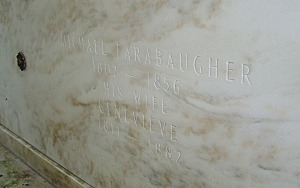No. 6: Who is buried in Michael Farabaugh’s tomb?
If you start where this sign marked the old section of the Loretto Cemetery and walk up the hill, you will soon know that something is terribly wrong. Newer markers are next to the old; there are bald spots where graves used to be; the rows are uneven; and if you dig a bit in the grass you will find parts of old markers. There is a circa 1890 picture of the cemetery from the same vantage point, and the line of stones shown is very different.
According to lifelong Loretto resident Leo Noll, the cemetery became so overgrown in the 1930s or 1940s that he and some other workers removed large sections of headstones to more easily cut down the growth. But when it came time to put them back, they discarded the unsalvageable stones and then had to guess the original locations for the rest. This must be why the old photos of the cemetery show a different alignment of stones.
So now we have unmarked graves and pioneers buried under the wrong headstones. It would be possible to reconstruct the burials if records or a cemetery plot were maintained. No such luck. Prince Gallitzin certainly kept burial records from 1799 until his death in 1840. But there is no proof that such records were kept by his successors for the rest of the century. When Fr. Ferdinand Kittell published his Souvenir of Loretto Centenary in 1899, he included an alpha cemetery listing that he indicates (at page 165) was “chiefly” based on the headstones arranged there, and not parish records. Kittell’s project was worthwhile, but in the process he carted up the vital records the church did have (including the loose set of Prince Gallitzin’s burial records) and headed off to a monastery near Rome to compile an index, which then was transcribed for the Souvenir. All well and good, except he fumbled away all of those original records and his handwritten index. So he left us with a transcription of a transcription, and today we have no original records from the 1840-1899 era whatsoever. Lucky for us, Kittell inexplicably left behind Gallitzin’s two volumes of births, marriages and deaths, which we still have — but this is all pre-1840.
If you are confused, take heart. There is a fantastic effort here to make sense of all of this by pulling together nine different sources, to the credit of Lisa Baker, Jane Tripp and Jim Crouse.
This brings me to the mystery of the immigrant Michael Farabaugh (1808-1856). Michael had several occupations. In Germany, he was a Bierbauer (i.e. a beer brewer), so I like him already. He was also a Kufermeister (a cooper, who made staved wooden containers or barrels held together by slatted wooden hoops). He and his wife Eve brought their family to the U.S. in about 1841, and bought property at what is now Munster Township, in 1848. He was a farmer and probably stonemason too, although the 1850 Census lists his principal occupation as cooper. After this, all knowledge of him mysteriously disappears. No picture, no physical description, no stories, no death record, no newspaper article, no will – no nothing. He dies in 1856 at the age of 48 or 49 for no known reason, and today has two tombs at the Loretto Cemetery, shown below. Where is he really buried?
The deeply-chiseled 1856 headstone of “Michael Farabaugher” (first picture above), is still there at the Loretto cemetery, but his remains are probably not at that spot. He was the grandfather of Loretto’s famous son, Charlie Schwab. After the Schwab Mausoleum (second picture above) was built, Michael’s name was inscribed in marble on the inside facing of what appears to be a drawer crypt, with a keyed lock release mechanism (3rd picture above).
I don’t know when the mausoleum was built, but we can infer that Michael was dug up and put into this crypt at some point in time — perhaps when Schwab arranged for Gallitzin’s remains to be transferred to his monument by the church in around 1899, or perhaps around the time Schwab himself died in 1939. If Michael’s remains were not dug up and transferred, there is a real good chance that he was part of the tombstone scramble described by Leo Noll. Either way, I think it is unlikely he still lies beneath the nice-looking stone erected in 1856.
Here’s a scenario: If he was subjected to the tombstone scramble and then the remains beneath the headstone’s new location were dug up and transferred, there is a really good chance that somebody else’s bones are in that mausoleum. One thing is for certain: Michael is a man with two tombs today. Pretty creepy.
Incidentally, the disheveled graveyard with its diseased elms, slippery slopes and lack of lighting was a favorite Halloween destination when I was a kid. The only thing it lacked was a good old creaky gate. The older boys always promised there would be an event there, so when we finished up getting candy in town we would take the side trip, wait and see, and consult a few of the inscriptions. R.I.P. Michael, wherever you are.




